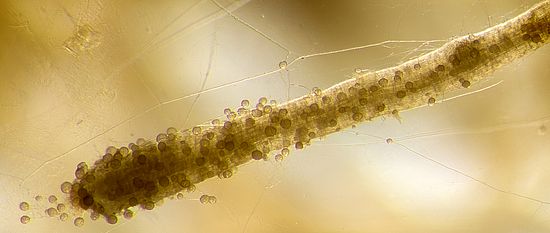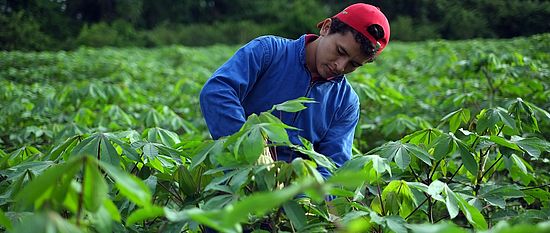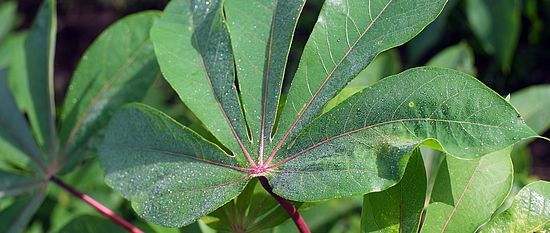Genetics and evolution of the mycorrhizal symbiosis
Molecular Genetics and Evolution
Our work focuses on the mycorrhizal symbiosis between plants and arbuscular mycorrhizal (AM) fungi. The symbiosis occurs in the majority of terrestrial plant species. Through the effects of the fungus on plant phosphorus acquisition, plants benefit and can grow better when forming the symbiosis. The association is ancient and our group seeks to understand the genetics and evolution of these important fungi and how AM fungal genetics can influence plant growth.
We have demonstrated three features of AM genetics that have important consequences for how plants grow. First, the fungi harbour genetically different nuclei in a common cytoplasm. Second, the fungi can fuse and the nuclei can mix giving rise to genetically novel AM fungi. Third, segregation of nuclei occurs during spore formation, giving rise to genetically different AM fungi. Both mixing of nuclei and segregation have important conseqences on the growth of rice. We manipulate the genetics of AM fungi using these processes to study which genes are affected in the plant by genetic changes in the fungus. These processes are natural and involve no gene insertion. A part of our work involves applying this technology to produce new strains of AM fungi for commerical inoculation of crops in Colombia (in collaboration with the National University of Colombia).
Research topics
- Genetics and evolutionary genetics of AM fungi
- Influence of AM fungal genetics on the symbiosis with plants
- Importance of AM fungal diversity on plant communities
- Biotechnological application of AM fungi in tropical agriculture in Colombia
Publications
► Google Scholar: https://scholar.google.ch/citations?hl=de&user=i11IgWMAAAAJ
- Trait evolution during a rapid global weed invasion despite little genetic differentiation
RE Irimia, D Montesinos, A Chaturvedi, I Sanders, JL Hierro, G Sotes, ...
Evolutionary Applications 2023 - Integrating plant and fungal quantitative genetics to improve the ecological and agricultural applications of mycorrhizal symbioses
E McGale, IR Sanders
Current Opinion in Microbiology 70, 102205 1 2022 - Reciprocal recombination genomic signatures in the symbiotic arbuscular mycorrhizal fungi Rhizophagus irregularis
ID Mateus, B Auxier, MMS Ndiaye, J Cruz, SJ Lee, IR Sanders
Plos one 17 (7), e0270481 2022 - Decreasing relatedness among mycorrhizal fungi in a shared plant network increases fungal network size but not plant benefit
van't Padje, Anouk; Klein, Malin; Caldas, Victor; Galvez, Loreto Oyarte; Broersma, Cathleen; et al.
Ecology Letters 10.1111/ele.13947 FEB 2022 - Generation of unequal nuclear genotype proportions in Rhizophagus irregularis progeny causes allelic imbalance in gene transcription
Robbins, Chanz; Cruz Corella, Joaquim; Aletti, Consolee; Seiler, Rejane; Mateus, Ivan D.; et al.
New Phytologist 10.1111/nph.17530 SEP 2021 - The methylome of the model arbuscular mycorrhizal fungus, Rhizophagus irregularis, shares characteristics with early diverging fungi and Dikarya
Chaturvedi, Anurag; Corella, Joaquim Cruz; Robbins, Chanz; Loha, Anita; Menin, Laure; et al.
Communications Biology 10.1038/s42003-021-02414-5 JUL 22 2021 - The Phosphate Inhibition Paradigm: Host and Fungal Genotypes Determine Arbuscular Mycorrhizal Fungal Colonization and Responsiveness to Inoculation in Cassava With Increasing Phosphorus Supply
Venegas, Ricardo Alexander Pena; Lee, Soon-Jae; Thuita, Moses; Mlay, Deusdedit Peter; Masso, Cargele; et al.
Frontiers In Plant Science 10.3389/fpls.2021.693037 JUN 22 2021 - Co-existence of AMF with different putative MAT-alleles induces genes homologous to those involved in mating in other fungi: a reply to Malar et al.
Mateus, Ivan D.; Lee, Soon-Jae; Sanders, Ian R.
Isme Journal 10.1038/s41396-021-00979-x Early Access: MAY 2021 - Hierarchical spatial sampling reveals factors influencing arbuscular mycorrhizal fungus diversity in Cote d'Ivoire cocoa plantations
Rincon, Cristian; Droh, Germain; Villard, Lucas; Masclaux, Frederic G.; N'guetta, Assanvo; et al.
Mycorrhiza, 10.1007/s00572-020-01019-w FEB 2021 - Genetically Different Isolates of the Arbuscular Mycorrhizal Fungus Rhizophagus irregularis Induce Differential Responses to Stress in Cassava
Pena, Ricardo; Robbins, Chanz; Corella, Joaquim Cruz; Thuita, Moses; Masso, Cargele; Vanlauwe, Bernard; Signarbieux, Constant; Rodriguez, Alia; Sanders, Ian R
Frontiers In Plant Science,10.3389/fpls.2020.596929 DEC 2 2020 - Greater topoclimatic control of above- versus below-ground communities
Mod HK; Scherrer D; Di Cola V; Broennimann O; Blandenier Q; Breiner, FT; Buri A; Goudet, J; Guex, N; Lara, E; Mitchell, EAD; Niculita-Hirzel, H; Pagni, M; Pellissier, L; Pinto-Figueroa, E; Sanders, IR; Schmidt, BR; Seppey, CVW; Singer, D; Ursenbacher, S; Yashiro, E; van der Meer, JR; Guisan, A
Global Change Biology DOI: 10.1111/gcb.15330 DEC 2020 - …

Prof. Dr. Ian R. Sanders
University of Lausanne
Department of Ecology and Evolution
1015 Lausanne
Tel: +41 (0)21 692 42 61
Publications
Interdisciplinary
- Molecular genetics
- Ecology
- Evolution
- Agronomy
- Plant – microbe interactions



